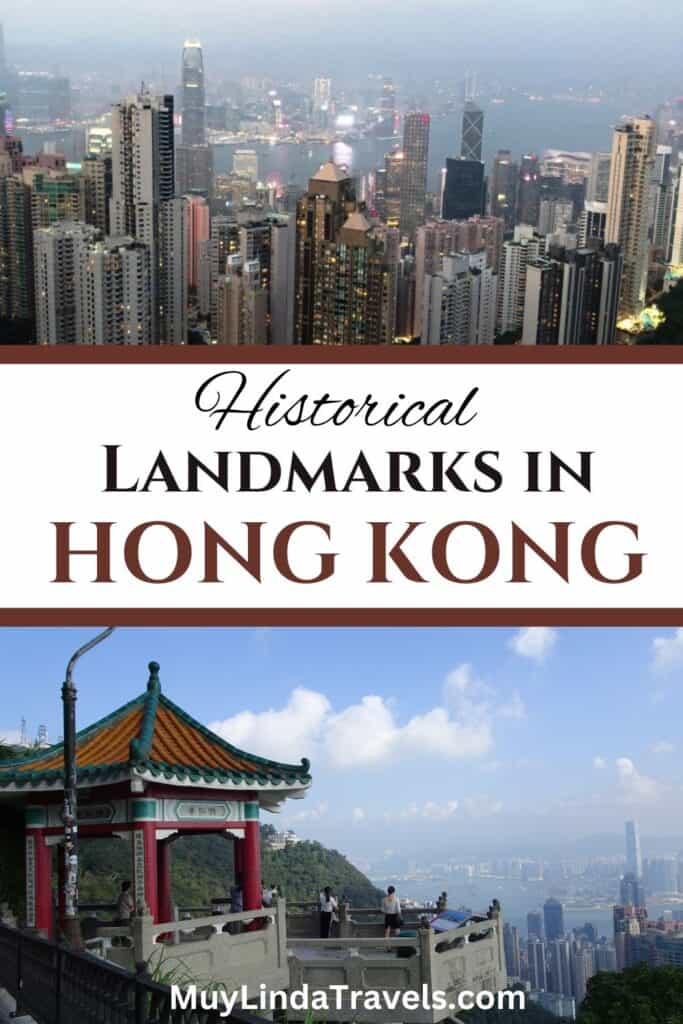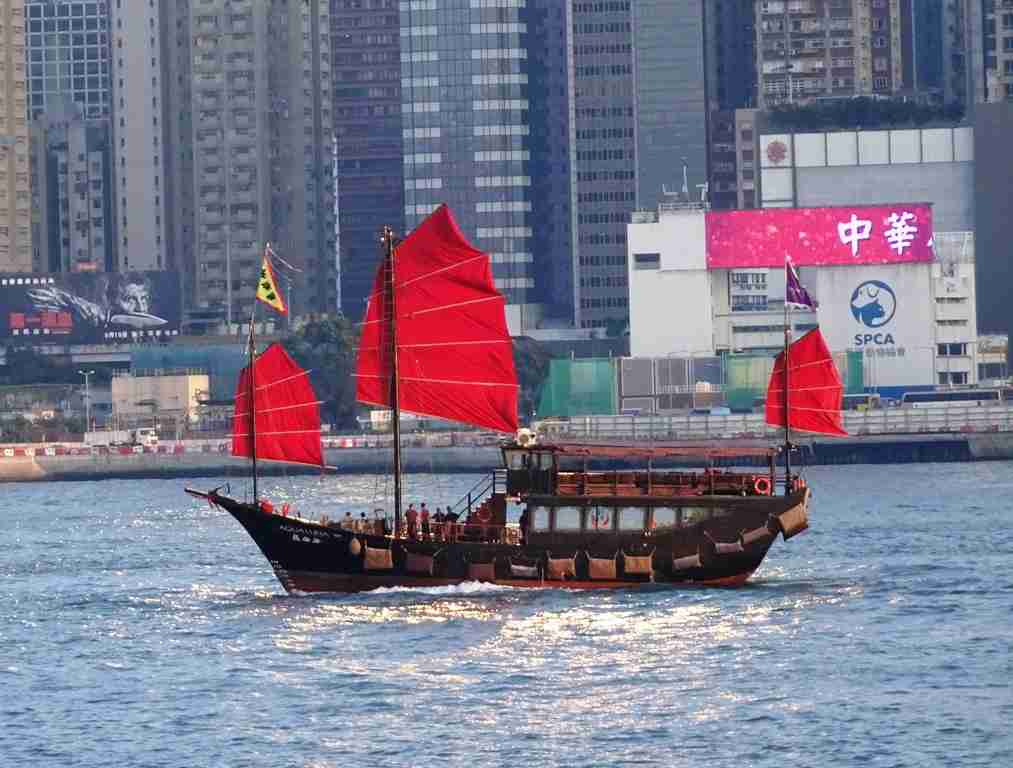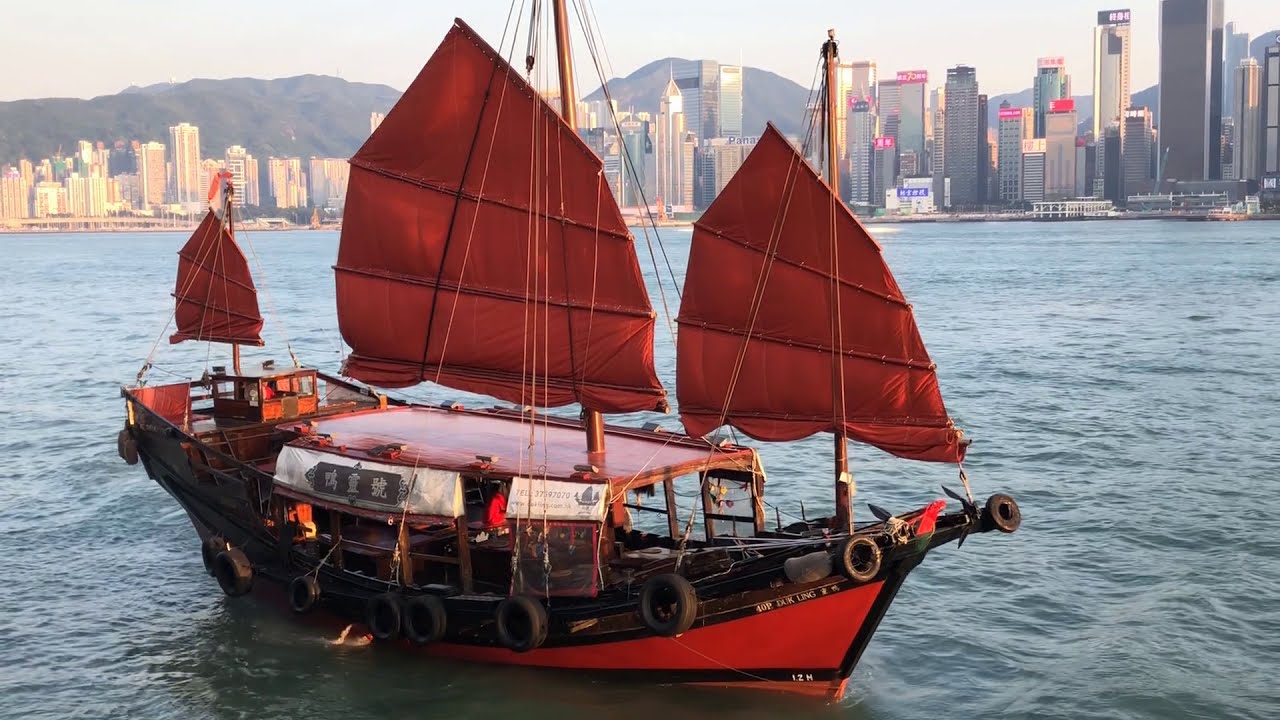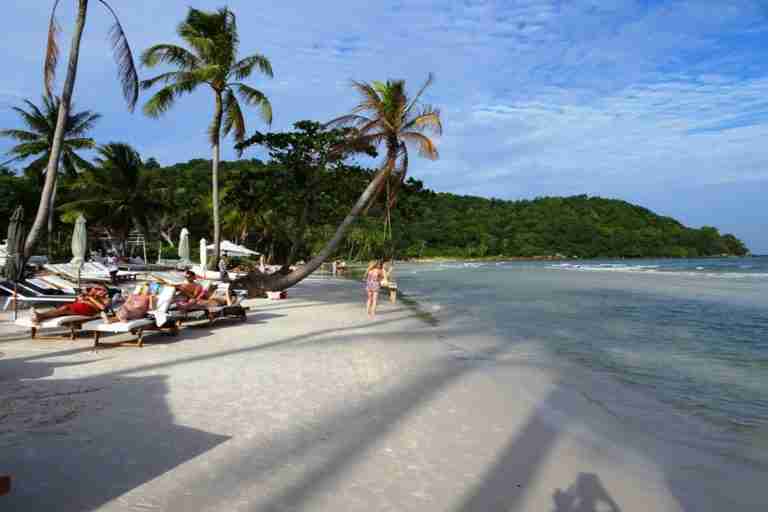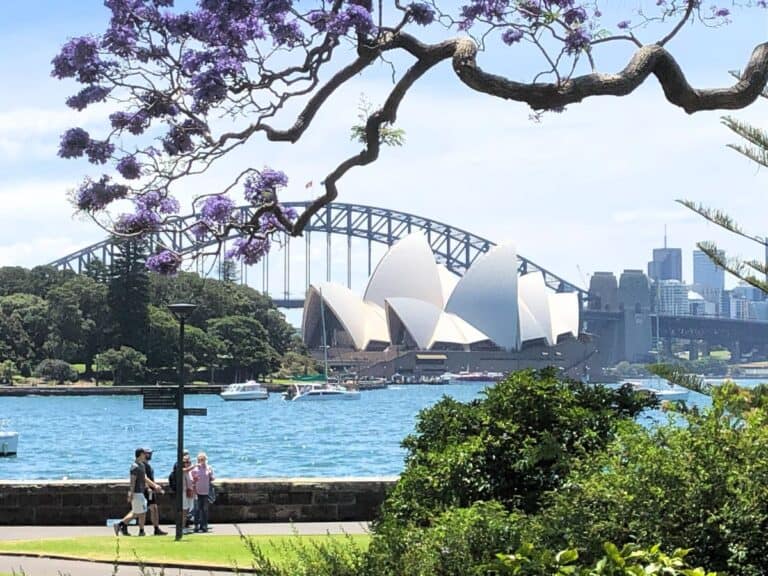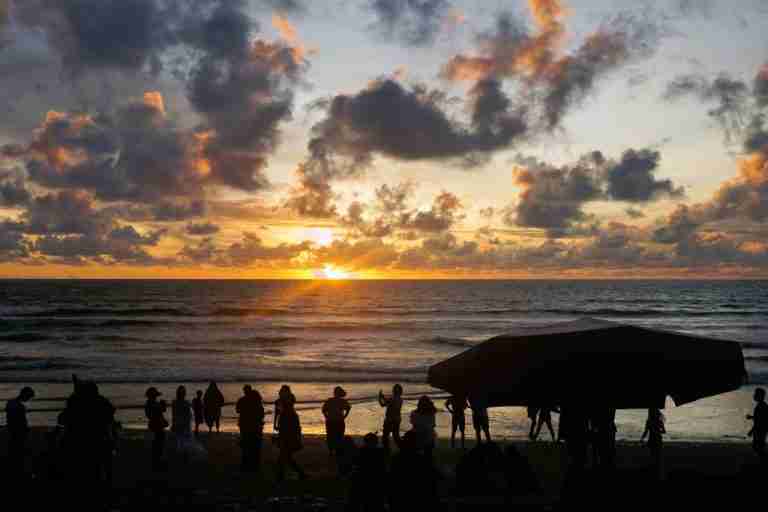25 Best Hong Kong Historical Landmarks & Attractions
Are you looking for historical landmarks in Hong Kong to add to your itinerary?
The historical attractions in Hong Kong make it a fascinating place to visit. A financial centre and a modern city full of high-rise apartments and office blocks, Hong Kong blends its ancient Chinese culture with British colonial history and European-style buildings.
I’ve visited Hong Kong twice as a solo traveller and I had fun visiting viewpoints, temples, historical buildings, museums and markets. I enjoyed discovering the old historical places in Hong Kong within the new, very modern city.
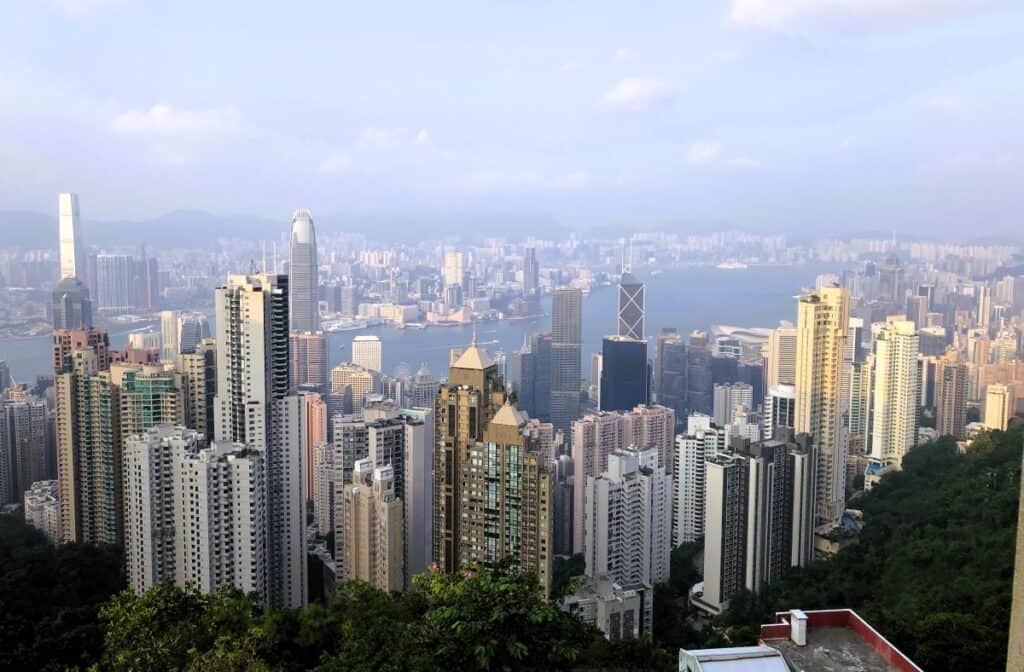
Some of the links on this page are affiliate links and I may make a small commission on sales from those links. This does not cost you extra and helps keep this website running. I appreciate your support!
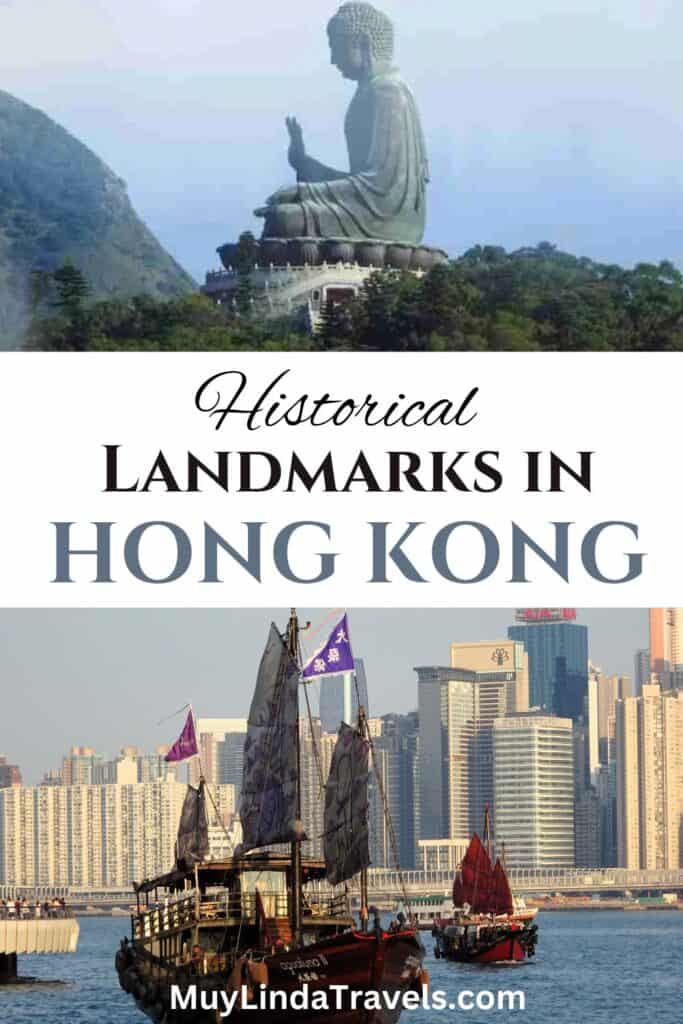
Best Hong Kong Historical Landmarks & Attractions
1. Victoria Peak
Victoria Peak is one of the most famous landmarks of Hong Kong. An upmarket residential area at the top of Mount Austin, the popular viewpoint at The Peak is where you’ll find the classic view of the Hong Kong city skyline.
Also on The Peak, there are some lovely parks and walking trails that are worth exploring. Victoria Peak Garden was once the site of the Governor’s summer residence and it’s now a lovely English garden with Victorian pagodas and winding pathways.
To get there from the visitor’s centre, follow Mount Austin Road to Victoria Peak Garden and from there keep following the path to the Lugard lookout and enjoy sweeping views over the other side of Hong Kong Island.
The historic Peak Tram from Garden Road in Admiralty takes passengers up the steep slope to the lookout point at Victoria Peak.
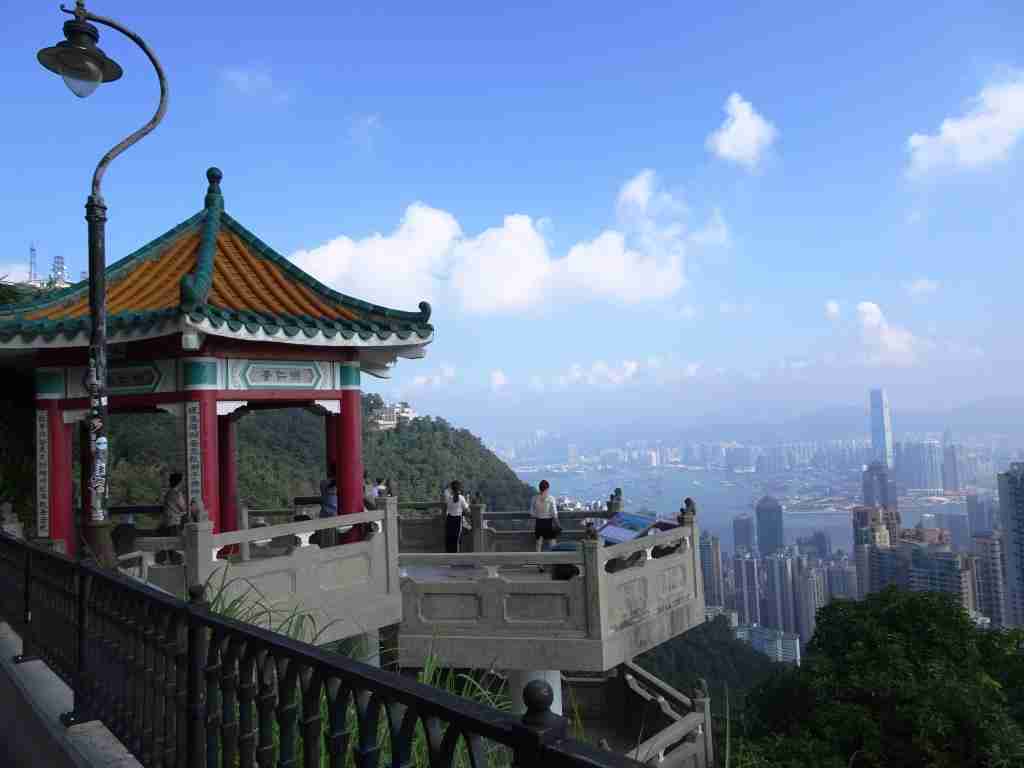
2. The Peak Tram
The Peak Tram is one of the top historical attractions in Hong Kong. Step back in time and enjoy Hong Kong’s colonial charm riding one of the world’s oldest and most famous funicular tramways. It operates on a cable system on the steep slope and is one of the most popular tram rides in Hong Kong.
TIP: Buy your tickets for the Peak Tram in advance and skip the long queues at the ticket office. There were crowd control measures in place last time I was there.
The Peak Tram service began operating in 1888 and is the most direct way to travel to Victoria Peak and it’s popular with locals and tourists. I enjoyed the ride as a solo traveller in Hong Kong and there are spectacular views on the way up the mountain.
TIP: The view from the Peak Tower complex is amazing but you can see an almost identical view for free from the Lions Pavillion a short walk away.
3. St John’s Cathedral
Across the road from the Peak Tram station is St John’s Cathedral, a historic building in Hong Kong Central, one of the best areas to stay in Hong Kong. The Cathedral of St John the Evangelist is one of the oldest churches in Hong Kong and has been serving the community for more than 175 years.
St John’s has a long history from British colonial days and is owned and run by the Church of England. Services are held on weekends and online.
I walked up the historic Battery Lane to St John’s Cathedral and there was a service in progress when I was there.

4. The Court of Final Appeal
A short distance from St John’s Cathedral is the Court of Final Appeal, a historic building in Hong Kong that’s neo-classical in style with impressive columns and archways.
The Court of Final Appeal was established in 1915 and overlooks Statue Square with fountains and decorative garden beds. It sits next to the Cenotaph War Memorial and is surrounded by high-rise buildings and tall office blocks.
5. Cenotaph War Memorial
The Cenotaph War Memorial is a Hong Kong historical landmark that was built in 1923 to remember the soldiers killed in the First World War. Today the Cenotaph is a monument that commemorates those who died in the Second World War and the Japanese Invasion of Hong Kong.
Remembrance Day and ANZAC day services are held here with wreaths, prayers and recitations in a multi-faith ceremony that includes a performance of “The Last Post” bugle call.
6. Flagstaff House & The Museum of Tea Ware
A short walk away from the Cenotaph is Flagstaff House, a historic building in Hong Kong. Flagstaff House was built in 1846 and was the home of the Commander of the British Army in Hong Kong during colonial days.
Also known as Headquarters House, Flagstaff House was situated near the waterfront on Victoria Harbour above the military Barracks and the grounds are now Hong Kong Park a much-needed green space in the busy Central area.
Flagstaff House has been restored and today houses The Museum of Tea Ware, dedicated to the Chinese Tea Ceremony and the appreciation of fine tea.
I enjoyed visiting the Flagstaff House Museum and bought some good quality tea from the museum shop as a souvenir.
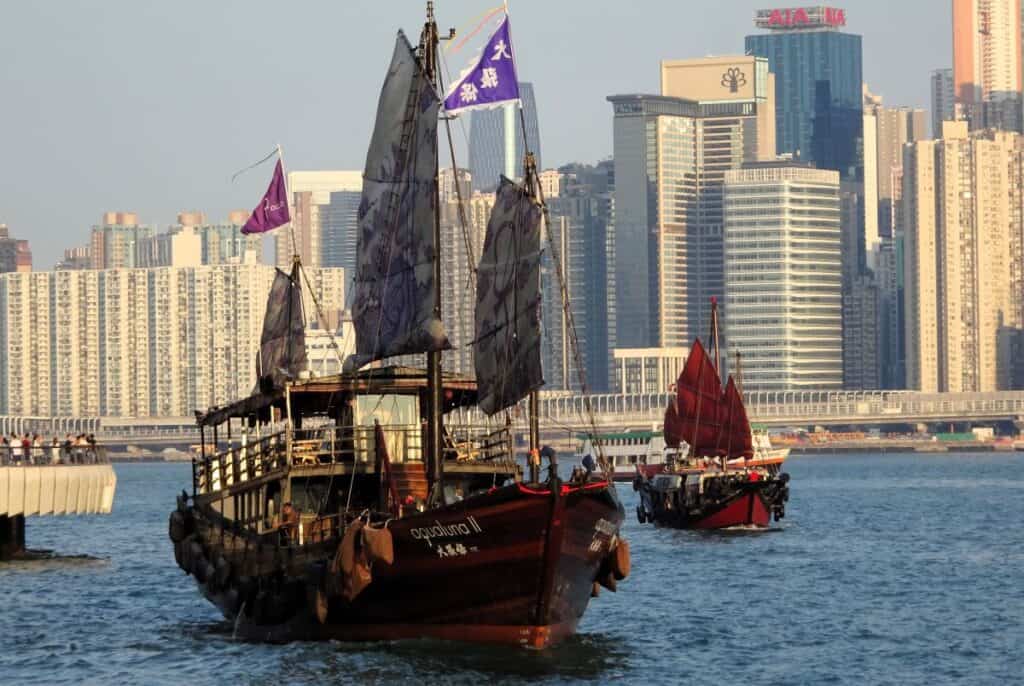
7. Victoria Harbour
Victoria Harbour is one of the most famous landmarks in Hong Kong. It separates Hong Kong Island from Kowloon and was named in honour of the English Queen Victoria. During colonial days, the busy port brought trade and prosperity to Hong Kong.
The name “Hong Kong” means “fragrant harbour,” and the islands of Hong Kong became known for the sweet-smelling incense transported from Victoria Harbour.
Victoria Harbour has water deep enough to accommodate large container vessels and huge cruise ships and there are some traditional Chinese junk boats still sailing on the harbour. You can see them from the Tsim Sha Tsui Promenade.
Hong Kong Highlights Video
Here are some highlights and attractions in Hong Kong…
8. Tsim Sha Tsui Promenade
With a stunning location on Victoria Harbour, the Tsim Sha Tsui Promenade is another famous landmark in Hong Kong near the Star Ferry pier. Stroll along the waterfront, watch the boats sail past and enjoy spectacular views from Kowloon across the harbour to Hong Kong Island.
The Tsim Sha Tsui Promenade is more than a kilometre long and it’s where you’ll find the Avenue of Stars, a collection of sculptures of famous Hong Kong film stars like Bruce Lee.
The Promenade is a beautiful place to watch the sunset over the harbour and the FREE “Symphony of Lights” laser show at 8:00 PM (HKT) every night. Catch the Star ferry from Hong Kong Central Pier and get there early to find a good vantage point.
9. The Clock Tower
The Hong Kong Clock Tower was built in 1915 and was once part of the Kowloon Railway station near the Tsim Sha Tsui Promenade and the Star Ferry pier. In 1975 the railway station was moved to Hung Hom and the station building was knocked down to make way for the Hong Kong Cultural Centre and Space Museum.
Today, the Clock Tower is all that remains, a Hong Kong historical landmark that keeps time in Tsim Sha Tsui.
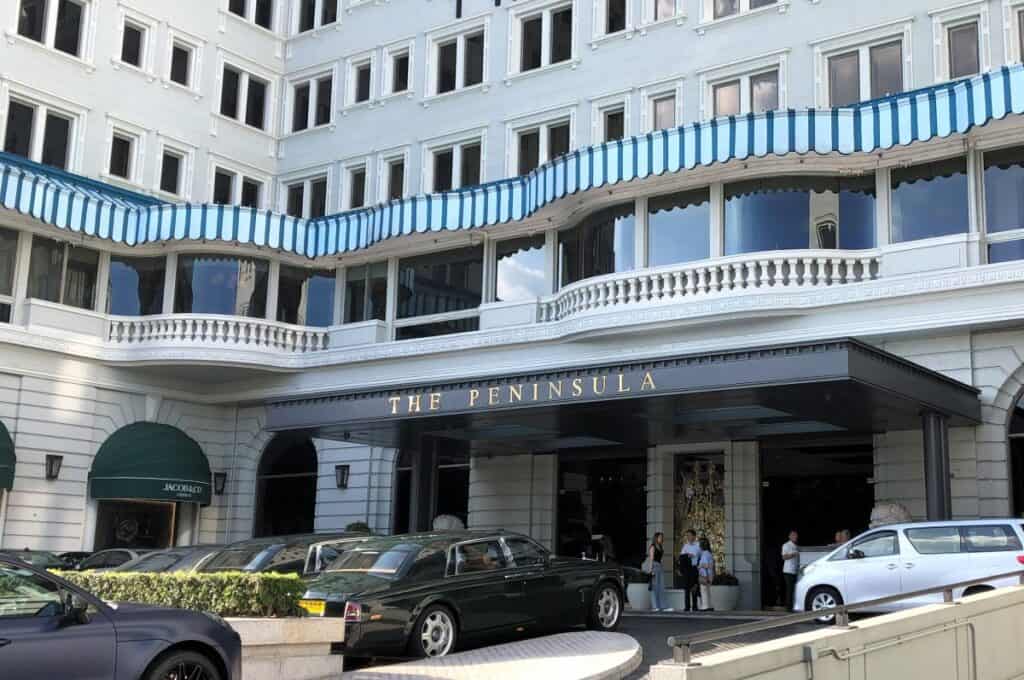
10. The Peninsula Hotel
Also in Tsim Sha Tsui, the luxurious Peninsula Hotel is a historical landmark in Hong Kong in an upmarket area just across the road from the Museum of Art. The Peninsula was built in 1928 and is a mixture of 19th-century French and Edwardian architecture and has high ornate ceilings and crystal chandeliers.
For more than a century, The Peninsula has served an elegant afternoon tea in the Lobby of the hotel. On a recent visit to Hong Kong, I spent a delightful afternoon enjoying delicious scones, sweets, sandwiches and a pot of fine tea. The tradition of afternoon tea comes from British colonial days and is now firmly a part of Hong Kong culture.
11. The Star Ferry
The iconic Star Ferry began taking people across Victoria Harbour in 1880. Formerly known as the Kowloon Ferry, The Star Ferry played an important part in the colonial history of Hong Kong and is now a Hong Kong historical attraction.
The Star Ferry leaves from Central Pier 7 every 5 – 10 minutes and the crossing to Kowloon takes about 10 minutes. From the Kowloon side of the harbour, there’s a spectacular view of the skyscrapers and high-rise buildings on Hong Kong Island.
Riding on the Star Ferry is something you don’t want to miss on a visit to Hong Kong. It’s the cheapest Harbour cruise in Hong Kong and one of the most scenic in the world.
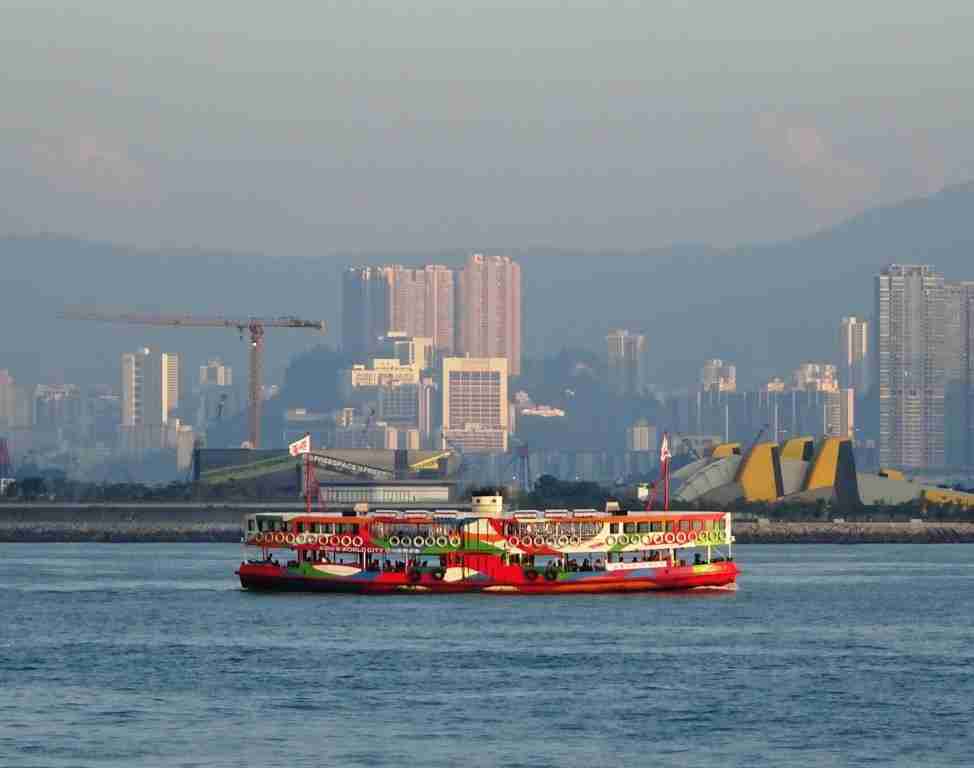
12. Traditional Chinese Junk Boats
Victoria Harbour is now a modern port but it was once full of traditional Chinese junks and fishing boats. Their brightly coloured sails and wooden decks are a historical landmark in Hong Kong and you can watch them sail past from vantage points along the harbour in Kowloon and Hong Kong Island.
Traditional Chinese Junk boats like the Aqua Luna & the Dukling cruise Victoria Harbour with passengers on board. These restored vessels are especially beautiful at night when their sails are lit up.
13. Historic Trams
A Hong Kong historical attraction and a remnant of colonial days, the narrow double-decker trams on Hong Kong Island are a fun way to get around. However, I discovered that comfort was not a priority in the early 1900s as I climbed the narrow stairs to the top deck and bumped around on the hard wooden seats.
The old narrow-gauge trams operate from Kennedy Town to Shau Kai Wan and Happy Valley. On the early trams, conductors would collect the fares but these days you can pay your fare with an Octopus Card.

14. The Man Mo temple
A small and unassuming historical building in Hong Kong, the Man Mo Temple is a short walk from Hong Kong Central on Hollywood Road in Sheung Wan. Inside the small temple, the air is heavy with burning sandalwood incense. Lanterns and red incense coils hanging from the ceiling.
I loved visiting this tiny Chinese temple and it was a fascinating glimpse into the Taoist religion in Hong Kong. I watched the worshippers lighting incense sticks, bowing and praying at the altar.
The Man Mo Temple was built in the 1800s during the Qing Dynasty and is dedicated to the Chinese Gods of Literature and War. During colonial times it was a place of worship but it was also used as a courthouse to settle local disputes. Oaths taken at the temple often included the beheading of a rooster.
Next door to the Man Mo temple is the Ancestral Hall, a place where local people perform the rituals of ancestor worship and pay their respects to the dead. The Man Mo Temple is one of the most interesting historical places in Hong Kong and is worth adding to a Hong Kong itinerary.
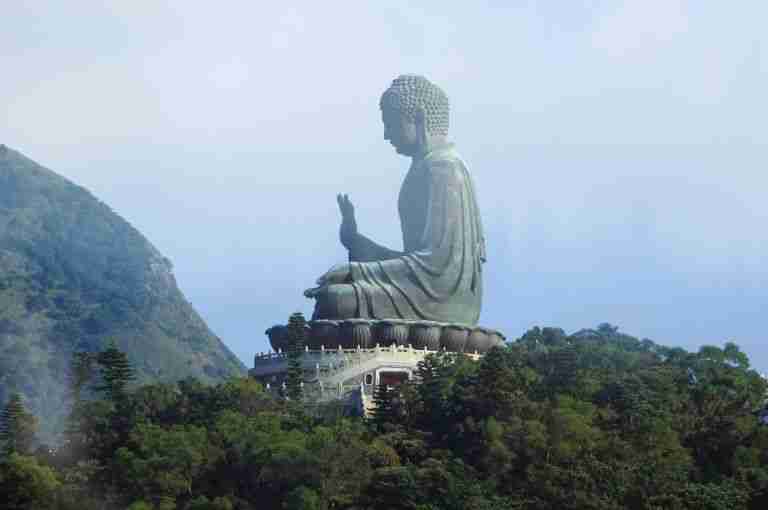
15. The Big Buddha
One of the most famous landmarks of Hong Kong, the Tian Tan Buddha or the Big Buddha draws visitors from around the world to Lantau Island. The majestic Big Buddha statue stands 34 metres tall, is made from bronze and is one of the largest outdoor Buddhas in the world.
The Big Buddha sits at the top of Mount Muk Yue Shan beside the Po Lin Monastery and Ngong Ping Village.
16. Nong Ping Cable Car
The Nong Ping Cable Car is another famous landmark of Hong Kong and takes passengers to Nong Ping Village at the top of the mountain to see the majestic Big Buddha statue and the Po Lin Monastery.
The scenic cable car ride has breathtaking mountain and sea views and is a highlight of visiting Hong Kong. It takes around 30 minutes to reach Ngong Ping Village and from there, it’s a short walk to the Big Buddha.
TIP: I waited for over an hour to buy my ticket so I suggest getting your Ngong Ping 360 cable car ticket in advance to skip the long queue at the ticket counter.
17. The Po Lin Monastery
The Po Lin Monastery is an important Hong Kong historical landmark that sits beside the beautiful Big Buddha statue in Nong Ping Village. The monastery was founded in 1906 by three Zen Buddhist monks visiting from China who loved the beautiful, tranquil scenery of Lantau Island.
Today, the Po Lin Monastery and the famous Big Buddha are top historical attractions in Hong Kong. The Monastery has an attractive shaded courtyard and is a lovely retreat from the heat. As I wandered through the monastery, a Buddhist ceremony was in progress and monks were chanting and praying.
The main temples at the Po Lin Monastery are decorated with colourful tiles and have beautiful statues of the Buddha representing his past, present and future.
To get there catch the MTR to Tung Chung or a ferry Ferries from Hong Kong Central Pier.
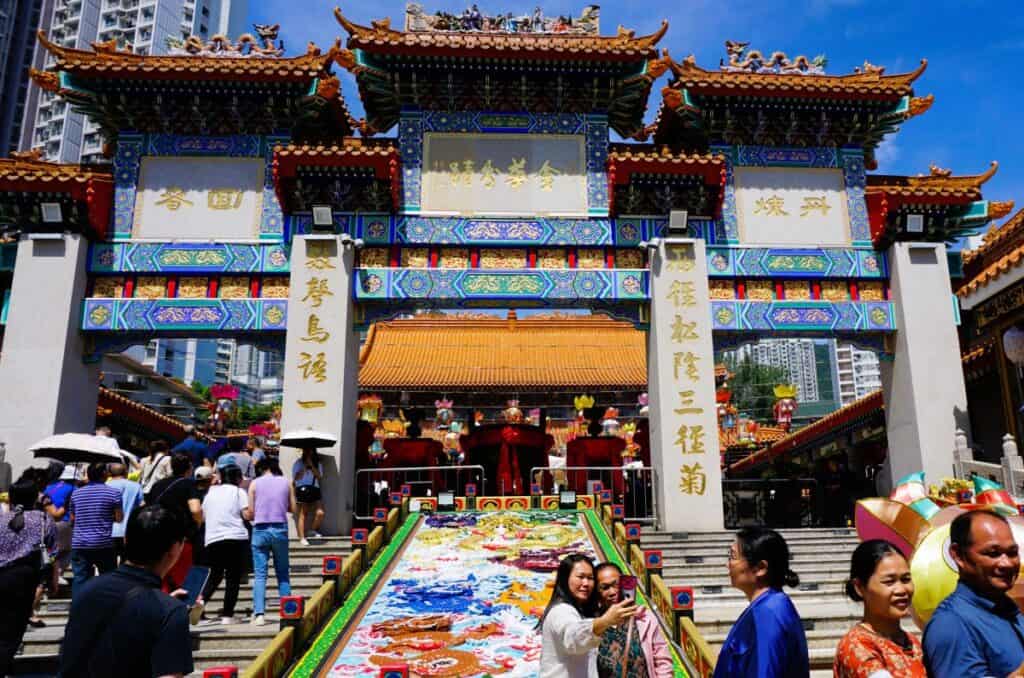
18. Sik Sik Wong Tai Sin Temple
The Sik Sik Wong Tai Sin Temple is a popular historical landmark in Hong Kong. The Taoist temple is dedicated to Wong Tai Sin, the “Great immortal Wong” and Chinese tourists flock here to have their fortunes told.
When I was visiting there were crowds of people at the temple and I was swept up the stairs with a large group of Chinese tourists. At the outdoor altar, people were lighting incense, bowing, praying and queuing for the Kau Chim fortune-telling.
To get there catch the MTR to Wong Tai Sin, just one stop away from Diamond Hill and the Chi Lin Nunnery.
19. Chi Lin Nunnery
The Chi Lin Nunnery is a Buddhist Temple complex and a historical landmark in Hong Kong. The temple is designed in a Tang Dynasty style and made from Cyprus wood. It’s a lovely place to visit to escape from the busy city areas of Hong Kong.
The temple complex has a large courtyard with lily ponds and water features in a harmoniously balanced design surrounded by shaded corridors lined with altars and Buddhist statues.
Founded in 1924 as a retreat for Buddhist nuns, the Chin Lin Nunnery is a peaceful place to visit in Hong Kong surrounded by lush green Chinese gardens and water features with tall apartment blocks in the distance.
To get there catch the MTR to Diamond Hill and from there, it’s a short walk to the Chi Lin Nunnery and the Nan Lian Garden.
20. Nan Lian Garden
The Nan Lian Garden is a beautifully landscaped green space and a historical place in Hong Kong that belongs to the Chi Lin Nunnery. The classical Chinese Garden design is from the Tang Dynasty like the Nunnery. At the centre of the garden, a golden pagoda sits in the middle of a lake.
There’s a waterfall at one end of the lake and several decorative wooden bridges leading across the lake to the pagoda. I found a shaded area amongst the trees to sit and enjoy the lush greenery and the peaceful atmosphere.
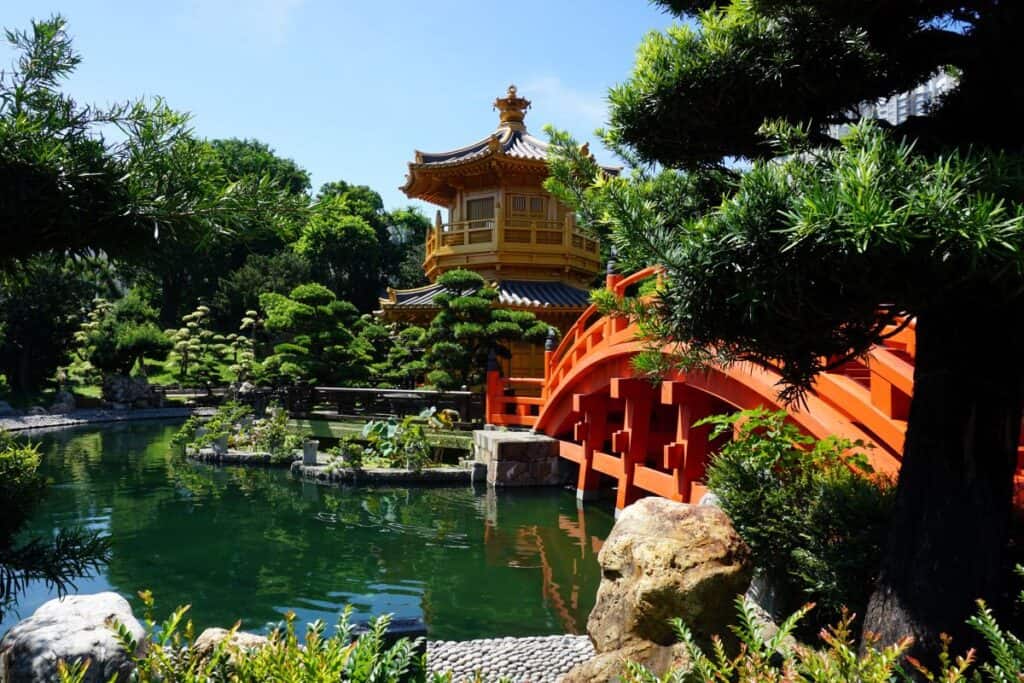
21. Ten Thousand Buddhas Monastery
The Ten Thousand Buddha’s Monastery, or Man Fat Tsz, is a Buddhist Temple and a historical attraction in Hong Kong. It’s a remarkable place to visit near Pai Tau village in the New Territories and was one of my favourite historical places in Hong Kong.
A steep path leads to the monastery at the top of Po Fook Hill. There are 431 steps and it takes around 20 minutes to climb to the top.
Lining the pathway are thousands of golden Buddha statues. Each of the statues is unique. There are young Buddhas, old Buddhas, and monks in meditation, praying and doing everyday activities. The goddess of mercy Kwun Yam is also among the statues.
The Ten Thousand Buddhas Monastery was built in 1965 and was funded by the local people of Hong Kong. No monks live at the monastery but it is a centre of worship for the local community. There are several temples, and in the main hall, the embalmed body of Yuet Kai is on show. He was the much-revered monk who built the monastery.
The Ten Thousand Buddhas Monastery is a bit off the beaten tourist path and is located in Sha Tin in the New Territories. But the monastery is unique and very special to visit so it’s well worth the effort to get there and it’s one of the more beautiful historical places to visit in Hong Kong.
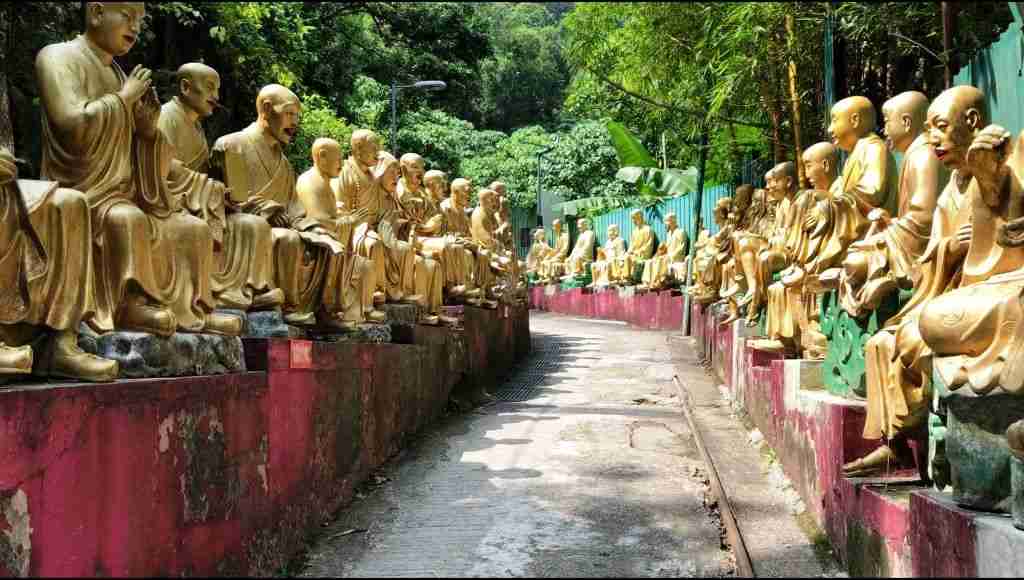
22. Hong Kong Museum of History
What better place to learn about Hong Kong’s history and culture than the Museum of History? The “History Through the Lens” exhibition shows photographs of early Hong Kong, and the” Hong Kong Story” exhibit gives a good overview beginning in prehistoric times.
People have lived on the islands of Hong Kong since the Stone Age, and the exhibit covers the historical development and folk culture in Hong Kong.
The Hong Kong Museum of History opens at 10:00 a.m. and is closed on Tuesdays. It is located in Kowloon on Chatham Road South next to the Hong Kong Science Museum in Tsim Sha Tsui.
23. Hong Kong Palace Museum
The Hong Kong Palace Museum is a landmark of Hong Kong on the Victoria Harbour waterfront. It houses Chinese treasures and historical objects of beauty. I loved visiting this museum and especially enjoyed the interactive historical exhibits about Life in the Imperial City in Beijing.
The Palace Museum is in the newly developed West Kowloon area and has a prime location on Victoria Harbour, next to the M+ Museum. To get there take the MTR to Kowloon and from there, it’s a 20-minute walk.
24. Hong Kong Heritage Museum
The Hong Kong Heritage Museum in Sha Tin is another historical place in Hong Kong to visit. The museum presents a mix of history, art and culture and is an entertaining and educational experience for visitors.
The Hong Kong Heritage Museum is located beside the Shing Mun River, and not far from the Ten Thousand Buddhas Monastery. You can catch the MTR or take a bus to get there.
**The Heritage Museum is closed on Tuesdays.

25. The Aberdeen Fish Market
Another historical place in Hong Kong worth visiting is the Aberdeen Fish Market. It has been operating since the 1800s on Aberdeen Harbour and is a landmark of Hong Kong that’s a bit off the beaten path. But it’s fun to shop with the locals and get a feel for Hong Kong’s seafaring origins.
Queue at the fresh fish stalls by the waterside on the waterside promenade and watch the fishermen selling their catch straight from their brightly coloured boats. It’s a fun way to start the day but make sure you get there early.
The markets are open from 4 am.
More Hong Kong Landmarks
Bank of China Tower
International Commerce Centre – SKY100 Observatory
Temple Street Night Market
Disneyland
Ocean Park
Timeline of Hong Kong’s History
- In 1557 the Portuguese settled in Macau, across the water from Hong Kong. This was the first European settlement in Asia and an important trading post for the beautiful silks and porcelain of China.
- At this time the islands of Hong Kong were sparsely populated with small fishing villages.
- In the mid-1800s, during the First Opium War, the British occupied the islands of Hong Kong.
- In 1841, China surrendered Hong Kong to the British and in 1842 the Nanking Treaty was signed to end the First Opium War. Trade in opium and other goods from Asia was lucrative and the British colony of Hong Kong became a commercial centre in Asia.
- In 1898 China leased Hong Kong to the British for 99 years. The ongoing growth of trade through the port in Victoria Harbour led to the development and growth of the city.
- From 1941 – 1945, during the Second World War, the British were unable to defend Hong Kong and the islands were occupied by the Japanese for almost 4 years.
- In the 1970s China opened up to foreign trade and introduced strict regulations. Hong Kong’s focus changed to financial services.
- In 1997 Hong Kong was returned to the Chinese after 156 years as a British colony.
- Hong Kong is now a Special Administrative Region of China with its own laws and judicial powers.
FAQs
What attracts tourists to Hong Kong?
Tourists are attracted to Hong Kong’s vibrant culture, colonial charm and stunning scenery. Hong Kong is famous as an international financial centre and has a top-notch food scene and a bustling nightlife. In 2025, Hong Kong is expected to be the most visited city in the world.
Is Hong Kong part of China?
Hong Kong is a Special Administrative Region of China. Although Hong Kong is officially controlled by China, it operates independently with independent laws, judicial powers and a degree of autonomy.
Do I need a visa to visit Hong Kong?
People from most nationalities can visit Hong Kong for up to 14 days without a visa. If you’re also visiting mainland China, you’ll probably need a visa.
Final Thoughts
These are some of the historical landmarks in Hong Kong that I have enjoyed. Hong Kong is an intoxicating mix of new and old with many historical attractions that are a wonderful addition to an itinerary.
Hong Kong has a rich history and I loved discovering the unique blend of Chinese and British heritage throughout the city.
You might also enjoy
A Fun 5 Day Hong Kong Itinerary
The Best Area to Stay in Hong Kong
A Guide to Successful Solo Travel in Hong Kong
Hong Kong Dragon’s Back Hike: A Stunning Coastal Walk
Lamma Island or Cheung Cha? Which Hong Kong Island is better?
The Popular Afternoon Tea at the Peninsula Hong Kong
A Delightful Day Trip to Macau from Hong Kong
The Ten Thousand Buddhas Monastery – A Hidden Gem
The Big Buddha in Hong Kong – A Stunning Day Trip
How to Avoid the Chinese Tea Ceremony Scam
A Stunning Day Trip to Hangzhou from Shanghai
Pin It! & Save this article for later
